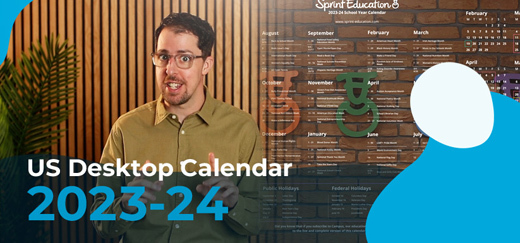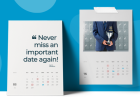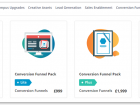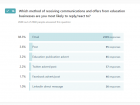What We've Learned After Examining 7,619 Subject Lines to Teachers
What We've Learned After Examining 7,619 Subject Lines to Teachers
Here are 8 different types of subject line you can write and how they perform in 2021.
Here are 8 different types of subject line you can write and how they perform in 2021.
Over the last few years, we’ve sent 7,619 different subject lines.
We’ve sent long ones, short ones, clever ones – and some not so clever ones.
In that time, we’ve learned a handful of things about subject lines and what gets educators to open an email.
8 Types of Subject Lines to Try
There’s one thing you learn several thousand emails down the road; there’s no silver bullet.
You can load your email subject line with high-calibre content one week, nail a bullseye, load it with the same round the next week, and get a completely different result.
The list of subject lines that work is as long as the list of subject lines that don’t.
So, instead of trying to sway you one way or the other, I’ll present the facts and a couple of nuggets of wisdom we panned out of a very long stream of emails.
Humorous Subject Lines
We love a good pun, even the bad ones, but a funny subject line isn’t always to everyone’s taste, so use them sparingly.
Humorous subject lines stick out in an otherwise bland, ordinary inbox.
They work best if you have already built some rapport with your audience and if it suits your tone of voice.
And while plenty of us enjoy a one-liner, they should still be concise and descriptive, like this:
Subject line: School leavers hoodies = sorted
Open Rate: 30.09%
Click-to-Open Rate: 69.66%
While it’s not a knee slapper, it’s comical and unusual enough to grab your attention.
It also checks all the boxes. It’s brief, descriptive, and makes excellent use of a term we all use informally in conversation.
The click-to-open rate is outstanding, likely owing to the sense of ease presented in the subject line.
Subject line: Music tours you’ll want to sing about
Open Rate: 31.92%
CTOR: 55.17%
It’s a bit cheesy, but it delivers.
This one tells us exactly what’s inside this email and how good it is.
It’s clever enough to make you think, ‘Aha, I see what you did there.’
Little quips like this offer insight into the character of your brand, giving an approachable impression.
Using FW:/RE: in Subject Lines
Here’s one we use on rare occasions, usually at the back of a sequence of emails.
It’s not my favourite because it’s a bit misleading.
The reason it stands out is that it appears to have come from an active exchange. As if a colleague or associate has forward something for your attention or replied to an email.
We have varied success with this type of subject line.
It will generate better than average open rates in many cases, but then results drop off when it comes to engagement.
If you’re optimising for opens, this may work. The trade-off is those recipients opened your email because they believed it was important, not necessarily because they’re interested in your offer.
Subject: FW: CBBFC Black Card competition
Open Rate: 30.27%
CTOR: 12.08%
Subject: FW: World Book Day
Open Rate: 43.64%
CTOR: 8.61%
Both of the above examples succeeded in securing above-average open rates, but the click-to-open rates then drop off a cliff.
Due to this type of subject lines deceptive nature, you may also see an uptick in unsubscribes.
Apply this technique sparingly and with caution.
Free Subject LInes
‘Free’ is hard to avoid.
Everyone loves a free resource, video lesson, guide, and what have you. If you’ve got a free offer you want teachers to know about, feel free to state that in your subject line.
But be aware.
While free stuff secures a boost in open rates, the term itself isn’t popular with spam filters.
If you’re going to promote a free offer, avoid using capitals, coloured text, and repetition. By all means, use ‘free’ to be descriptive, but avoid making it spammy.
Subject line: Free Sixth Form PSHE Video Lesson
Open Rate: 36.10%
CTOR: 34.03%
Personalised Subject Lines
Personalisation is a real winner.
If you can include something personal about your recipient or audience in the subject line, well, they’ll take that personally.
Take, for example, the below subject line.
It’s descriptive and immediately answers the location question.
Not only that, it stands out. Including a recipient’s name in a subject line is a common trick, but it’s rare to receive an offer specific to your location.
Subject line: Diwali Workshops in %%local_authority%%
Open Rate: 36.75%
CTOR: 20.08%
Here’s an example of a subject line that takes personalisation a degree further.
This school travel company used our database to send subject-specific lines to subject teachers and heads.
We were then able to personalise the emails further using dynamic content. So each teacher received information relevant to their interests.
All of which contributed to an excellent click rate.
Subject line: Our top three %%subject%% tours for 2020/21
Open Rate: 31.94%
CTOR: 43.97%
Long Subject Lines
Subject lines of all lengths will work, but past studies from Adobe Marketo, Mailchimp, and Return Path have all shown short subject lines produce better open rates.
That’s not to say you can’t win with long subject lines, but your long-term results might suffer.
We try to use seven words or less and front-load our most descriptive keywords. That way, the subject line preview displays information that encourages opens.
Below are a couple of examples of the results from long subject lines.
Subject: Teaching students remotely? Get complimentary access to home learning tools for the rest of the school year
Open Rate: 29.51%
CTOR: 29.39%
This subject line might be one of the longest we’ve ever sent, but its descriptive nature and construction managed to secure a good open and click-to-open rate.
Conversely, the following line offering teachers and students a chance at adventure appears to have missed the mark.
Despite an exciting invitation and a couple of household brands, this line achieves a fraction of the results of the previous line.
Why?
It is possible that while the line is exciting, it may have appeared consumer and travel-oriented, and teachers may have avoided opening it for this reason.
Subject: Join an epic expedition to the Arctic with LEGO City and National Geographic Kids
Open Rate: 22.97%
CTOR: 8.24%
Short Subject Lines
Following on from our most extended subject lines, here’s two of our shortest.
Short subject lines deliver consistently good results.
Their minimal nature means they’re quick and easy to read and comprehend, and their concise nature resonates well with busy teachers’ need for fast and clear communication.
While it’s only three words long, “Grab your skis!” packs a punch, insights action, and you immediately know what to expect.
Subject: Grab your skis!
Open Rate: 30.96%
CTOR: 23.54%
If you thought a three-word line was short, try this ultra-brief approach.
One word – “Celebrate”.
It’s not very descriptive, but it creates curiosity. Celebrate what? Should I be excited? What have we won?
Big words that create an emotional response make an impression and generate intrigue.
Subject: Celebrate
Open Rate: 30.43%
CTOR: 21.19%
Questions in Subject Lines
Posing a question in a subject line is a simple way to stand out in the inbox.
Combined with one of our aforementioned short subject lines and you’re on to a winner.
It works because the recipient feels compelled to respond, and it simply stands out from a visual perspective.
When you have an inbox full of unpunctuated email subject lines that are four words or longer – a single word invitation for a coffee is going to be the most noticeable.
Subject line: Coffee?
Open Rate: 40.10%
Click to Open Rate: 10.14%
Creating FOMO/Scarcity with Subject Lines
For whatever reason, we hate missing out.
Some lingering primal instinct within us can’t cope with the thought of missing a social event or deal, even if it leaves us with an almighty headache or a dent in our wallet.
Even if your recipients aren’t afraid of missing out, a subject line that creates scarcity is an excellent way to communicate a deal is coming to an end and spur them into action so as they don’t have to pay retail or a product down the line.
Here are a couple of textbook examples:
Subject line: Last chance to enter V&A Innovate
Open Rate: 29.99%
CTOR: 53.83%
Subject line: Hurry – 20% off ends soon
Open Rate: 26.02%
CTOR: 107.06%
While the open rates for these two emails were pretty typical, the click to open rates was outstanding.
Keep in mind these subject lines work best as notification emails, meaning your audience is already acquainted with your brand and offer.
To achieve the results seen here, you’ll want to send this line to an audience that is aware and engaged.
The Bottom (Subject) Line
There isn’t one thing you can do to secure a great open rate and CTOR - there are lots of things, so cut yourself some slack and stop agonising over a single subject line.
If you can’t decide, try some A/B testing and let your audience decide which they prefer.
We’ve had success and failure with them all, but our most consistent results come from concise, easy-to-understand subject lines that combine with digestible and easy-to-act-on email content.
Do you need some tips?
Are you unsure why you had a poor result?
Are you trying to replicate an outstanding campaign with little success?
Book a free edu-strategy call with one of our education strategists.
We’d be happy to chat about your current strategy and help you consider a new one.
Tags
Email Marketing
Similar Articles
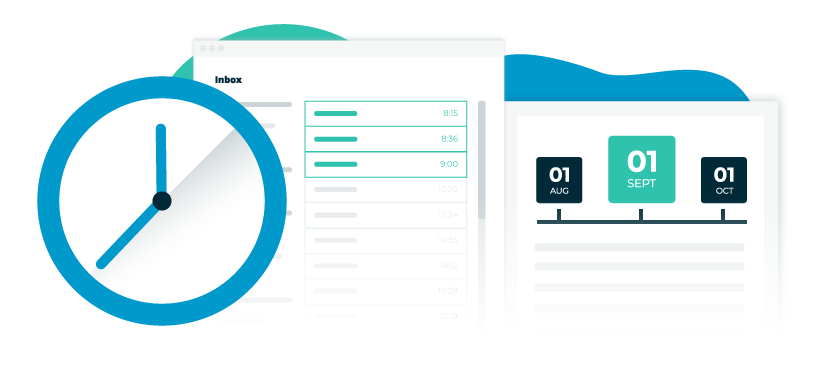

Turn timing your education emails into an artform!
Gain exclusive insights into the timing of your education marketing emails to engage with your target audience and increase your sales potential.


VIDEO: Selling to Schools Insights - Chapter 2 - Communicating with Schools
We analyse chapter 2 of The State of Selling to Schools 2023, discover how emails compare to social media and postal marketing, how often each is viewed and what leads to the most positive teacher responses.


Expert marketing to K-12 support and solutions
Expert marketing to K-12 solutions
Email Principals, Teachers, and District Staff Inboxes
Email teachers and staff inboxes
Sell More to US and Global Schools and Districts
Sell more to schools and districts















